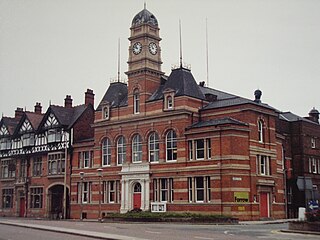
Towcester is a market town and civil parish in the West Northamptonshire unitary authority area of Northamptonshire, England. From 1974 to 2021, it was the administrative centre of the South Northamptonshire district.

South Northamptonshire was a local government district in Northamptonshire, England, from 1974 to 2021. Its council was based in the town of Towcester, first established as a settlement in Roman Britain. The population of the Local Authority District Council in 2011 was 85,189.

The Loughborough Town Hall is a building fronting onto the Market Place in Loughborough, Leicestershire, England. Built as a corn exchange and ballroom in 1855, it later became a municipal building and subsequently a theatre. It is a Grade II listed building. The building is still used for full council meetings of Charnwood Borough Council.

Northampton Guildhall is a municipal building in St Giles' Square in Northampton, England. It is a Grade II* listed building.

Bilston Town Hall is a municipal facility in Church Street, Bilston, West Midlands, United Kingdom. It is a Grade II listed building.

The Town Hall is a municipal building in Highgate, Kendal, Cumbria. It is a Grade II listed building. It serves as the headquarters of Kendal Town Council and also forms part of the complex of buildings which served as the headquarters of the former South Lakeland District Council.

Great Yarmouth Town Hall is a municipal building in Hall Plain, Great Yarmouth, Norfolk, England. The town hall, which is the meeting place of Great Yarmouth Borough Council, is a Grade II* listed building.

Hungerford Town Hall is a municipal building in the High Street, Hungerford, Berkshire, England. The town hall, which is the meeting place of Hungerford Town Council, is a Grade II listed building.

Eccles Town Hall is a municipal building in Church Street, Eccles, Greater Manchester, England. The town hall was the headquarters of Eccles Borough Council until the council was abolished in 1974.

Calne Town Hall is a municipal building in The Strand, Calne, Wiltshire, England. The town hall, which is the meeting place of Calne Town Council, is a grade II listed building.

Congleton Town Hall is a municipal building in the High Street, Congleton, Cheshire, England. The town hall, which is the meeting place of Congleton Town Council, is a grade II* listed building.

Retford Town Hall is a municipal building in The Square, Retford, Nottinghamshire, England. The town hall, which was the meeting place of Retford Borough Council, is a grade II listed building. It is still used for meetings of Bassetlaw District Council.

Ryde Town Hall is a municipal structure in Lind Street in Ryde, Isle of Wight, England. The town hall, which was the headquarters of Ryde Borough Council, is a Grade II listed building.

The Moot Hall is a municipal building in the High Street in Maldon, Essex, England. The building, which was the headquarters of Maldon Borough Council, is a Grade I listed building.

Tiverton Town Hall is a municipal building in St Andrew Street in Tiverton, Devon, England. The structure, which was the meeting place of Tiverton Borough Council, is a Grade II listed building.

Brackley Town Hall is a municipal structure in the Market Place, Brackley, Northamptonshire, England. The structure, which serves as the meeting place of Brackley Town Council, is a Grade II* listed building.

Helston Guildhall, also known as Helston Town Hall, is a municipal building in Church Street, Helston, Cornwall, England. The structure, which is the meeting place of Helston Town Council, is a Grade II* listed building.

Wirksworth Town Hall is a municipal building in Coldwell Street, Wirksworth, Derbyshire, England. The town hall, which was the headquarters of Wirksworth Urban District Council, now accommodates the local public library.

Kidsgrove Town Hall is a municipal building in Liverpool Road in Kidsgrove, Staffordshire, England. The building, which is the meeting place of Kidsgrove Town Council, is locally listed.

Sowerby Bridge Town Hall is a former municipal building in Town Hall Street in Sowerby Bridge, West Yorkshire, England. The building, which was initially used as the offices of the local board of health and as a public events venue, then as the home of the local Liberal Club and later as a bank branch, is a Grade II listed building.





















